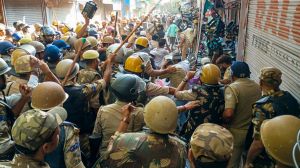With floods comes the gravy train
The ‘Bihar flood scam’ that the Express has been highlighting, shows the disconnect between policy, governance and knowledge. The ...

The ‘Bihar flood scam’ that the Express has been highlighting, shows the disconnect between policy, governance and knowledge. The flood drill when there is a threat of floods is well known. But if your agenda lies elsewhere, you merrily follow the gravy trail.
The first thing to note is that floods cannot be avoided. But they can be managed. Both when they occur and through preventive steps. There are two reasons for flood devastation. First, floods are irregular events. Second, flood plains are precisely those areas of great human concentrations because the great rivers were the cradles of civilisation and floods, believe it or not, also bring benefits like giving us life-giving silt and recharging groundwater aquifers. When a river withdraws, crops are grown in its bed. Notice how, when you travel by train in the dry season, how dry river beds are always cultivated. Very few villages with historical memories of floods actually move away from the river bank. But this does not mean that society should not have good ways to manage floods.
As I said, the flood evacuation drill is a known administrative procedure although it is not quite followed in recent times. I remember in the late ’80s, Naresh Chandra, then irrigation secretary, conducting one such drill in the Yamuna around Delhi. The law on evacuation and immediate relief is also quite clear. If evidence of diversion of funds on a large scale is available, the violation of rules will not be difficult to establish since flood relief is not quite a new administrative practice, although some leakage is probably there all the time.
Fortunately for UP, Bihar and West Bengal, the Reports of the Ganga Flood Control Commission are available and now also for the northeastern states for the Brahmaputra, based on the work done by A.D. Mohile. In fact, even when flood relief is organised, apart from the immediate steps, some attention should be paid to enduring solutions.
The most popular steps are to build embankments and to ask for the big dams to control rivers upstream. Like all dramatic “solutions”, they are only a part of the story if success is to be achieved and sometimes not even a major part. Experts know that river morphology is a complex affair and civil works without a larger understanding of training a river, can go wrong. So the hundreds of crores spent on embankments have not always led to much, even when the money was actually spent and not siphoned away.
In fact, we know by now that the drainage of the river and its flood waters is an important issue. It is known, for example, that faulty land use which results in blocking the drainage of a river or its large tributaries, can cause severe damage. It is therefore important to bring the larger community into confidence when planning flood control. But this is not done because the emphasis will then shift away from civil works and the gravy train.
Another way of managing a flood is to be ready with water bodies which will store the water in the flood, either under the ground or in talaavs. It was in the famous Bangladesh floods when an US presidential committee under Harvard’s Roger Reveille calculated that millions of acre feet of water could be stored under the ground in a flood if you pump out the water earlier and prepare the depressions to receive the flood waters.
Dams are important, but with a better understanding of the water rights of people and of the treatment of forest catchments, flood control measures per se are becoming less important. The classic case is the Mekong River Agreement, which provided for the minimum reverse flow of water in the monsoon into the Tonle Sap, a lake in Cambodia in the lower reaches of the river where large populations lived. This meant that the dams upstream, which were earlier designed by the great Indian engineer, Kanwar Sain, had to be re-sized.
In India downstream states like Tamil Nadu steadfastly resist the idea that they are sitting on great reservoirs of groundwater, just like Bangladesh, since they don’t want their claims on river waters questioned. Also, the way things are going with Nepal and Bangladesh, big dams will take some time to materialise. These countries need to recognise the potential of working together to transform islands of poverty into islands of prosperity. Bhutan — to take a recent example — is getting to become a developed country by trading in energy.
But, in the mean time, a lot of action is possible if Mani Shankar Aiyar will also get panchayats in the flood plains to adopt a master plan for flood management. If panchayats are involved, scams will be that much more difficult to perpetrate.







- 01
- 02
- 03
- 04
- 05
























